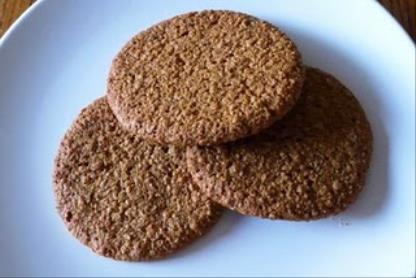

|
 (Or Thorcake or Thor or Tharf or Tharve Cake, also recorded as Tharf-kyek, Thaaf-keahyk, Thaf-kyek, Tharth-kyek, Thaugh-cyek, Thor Cake and Tharfy Cake) Thick (c 11/2ins) soft biscuit of wheatflour and oatmeal with butter, dark sugar and fuited with flavours such as candied peel, ginger and coriander seeds. Similar to the modern flapjacks The name may come from the Old English ‘theorf’ meaning plain or unprocessed or unleavened, in which sense it appears in the Lindisfarne Gospels of 950AD. It is possibly related to Harcake and to Parkin. Our correspondent Lynne Tann-Watson tells us that ‘British Popular Customs’ of 1876 reports that, as part of the celebrations for twelfth day in Cumberland, they eat tharve cake, “A large, flat, oaten cake baked on a girdle, sometimes with plums in it”.”  ‘Thor Cakes’ Image: http://www.wirksworth.org.uk Tharf Cake has a strong association with Halloween, from which it has become transferred, like many old customs, to November 5th. The ‘Miscellanies’ of the English Dialect Society for 1876 has; “THARF CAKE is a circular cake made from oatmeal butter and treacle In Sheffield it is eaten on the 5th of November. As All Souls Day is the second day of November it may be that the custom of eating tharf cakes which obtains in Sheffield on the 5th of November has reference to the soul mass cake formerly eaten on the Feast of All Souls and on that day distributed to the poor. But as these cakes are of a coarse hard kind the custom may relate to the old fast of Advent called La Potite Carème Quadragesima S. Martini or little Lent, a fast which one might call the autumnal Easter. A year or two ago I noticed that a shopkeeper in a good street in Sheffield advertised tharf cake for sale by a conspicuous handbill in his window. As a rule I find that people are ashamed of tharf cake. They call it parkin instead of using the old word. Tharf-cake, and tharf-bread meaning unleavened bread are common in early English literature Lancashire Evening Post – Tuesday 01 November 1904  Original receipt adapted from Peakland Heritage Original receipt adapted from Peakland HeritageA number of villages had ‘Tharf Cake Joinings’ on Bonfire Night, 5 November. Some recipes were baked in cake tins about 2 in (5cm) deep, but this version makes a kind of biscuit: Half a pound (230g) each of oatmeal, self-raising flour and sugar 6 oz (170g) black treacle 6 oz (170g) butter 1 oz (30g) candied peel 1 teasp baking powder Pinches of ground ginger, salt and coriander seeds Well grease a baking tray. Rub the butter into the dry ingredients and add the warmed treacle. Knead lightly before rolling out and cutting into thin rounds. Bake for about 10 minutes at 375F, 190C gas mark 5. For other seasonal traditions, see: Halloween  |
|
MORE FROM Foods of England... Cookbooks ● Diary ● Index ● Magic Menu ● Random ● Really English? ● Timeline ● Donate ● Royalty ● English Service ● Food Map of England ● Lost Foods ● Accompaniments ● Biscuits ● Breads ● Cakes and Scones ● Cheeses ● Classic Meals ● Curry Dishes ● Dairy ● Drinks ● Egg Dishes ● Fish ● Fruit ● Fruits & Vegetables ● Game & Offal ● Meat & Meat Dishes ● Pastries and Pies ● Pot Meals ● Poultry ● Preserves & Jams ● Puddings & Sweets ● Sauces and Spicery ● Sausages ● Scones ● Soups ● Sweets and Toffee ● About ... ● Bookshop ● Email: [email protected] COPYRIGHT and ALL RIGHTS RESERVED: © Glyn Hughes 2022 BUILT WITH WHIMBERRY |